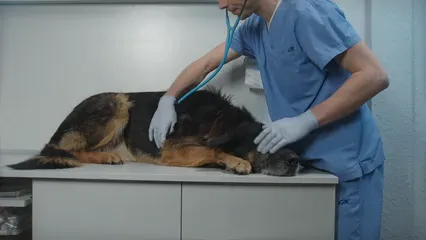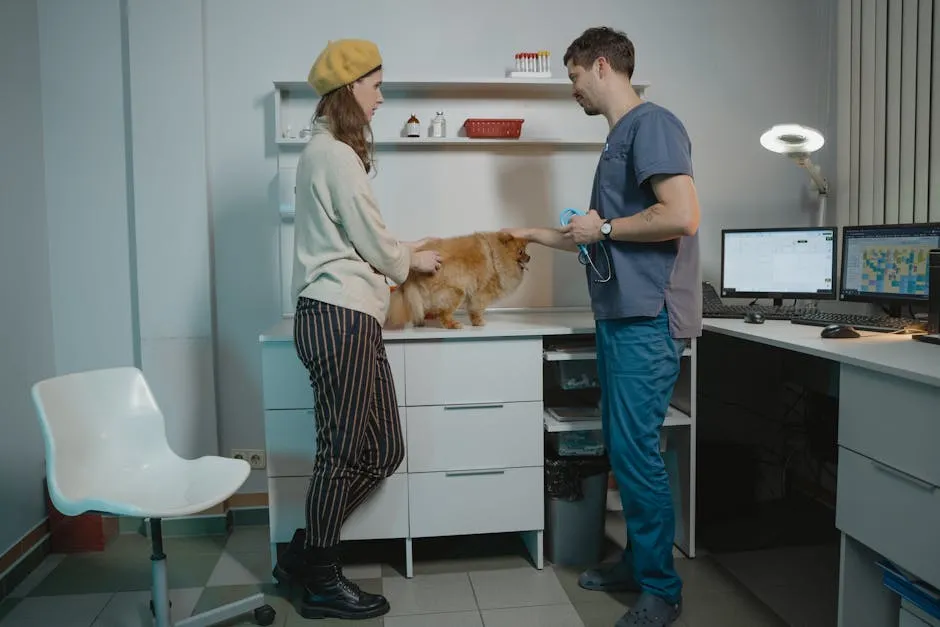Introduction
Have you ever wondered if dogs can have autism? This topic has sparked curiosity among pet owners and researchers alike. Understanding canine behavioral conditions is becoming increasingly important. More and more people want to know how to support their furry friends. This post will cover the signs, symptoms, and management strategies related to canine behavioral issues.
To keep your pooch entertained while you explore this topic, consider investing in some Dog Puzzle Toys. These interactive toys provide mental stimulation, helping to combat boredom and anxiety!

Summary and Overview
Autism, or Autism Spectrum Disorder (ASD), is a complex condition affecting humans. It involves challenges with social interaction, communication, and repetitive behaviors. While we can’t diagnose autism in dogs, some experts suggest there may be parallels. Canine Dysfunctional Behavior (CDB) has emerged as a term to describe behaviors that resemble autism in dogs. This concept is still debated among veterinarians and researchers.
Some believe that certain dogs exhibit autism-like traits, while others attribute these behaviors to anxiety or lack of socialization. As we explore the signs, causes, and treatment options, remember that understanding canine behavior is essential for their well-being.
If your dog struggles with anxiety, consider a Calming Dog Bed or an Anti-Anxiety Dog Jacket. These products can help provide comfort and security during stressful situations.

Understanding Autism and Canine Dysfunctional Behavior
What is Autism?
Autism, or Autism Spectrum Disorder (ASD), is a neurodevelopmental disorder. It affects social interaction, communication, and behavior. Individuals with autism may face challenges in understanding social cues and expressing emotions. Symptoms can range widely in severity and presentation. Some may exhibit intense interests or engage in repetitive movements.
Since autism exists on a spectrum, two people with the condition can show very different traits. This variability makes diagnosis complex, as each individual’s experience is unique.
Interestingly, parallels are drawn between autism in humans and certain behaviors in dogs. Some canines display signs such as social withdrawal and repetitive actions. These similarities have sparked discussions about whether dogs can have autism-like symptoms.
If your dog is showing signs of anxiety, consider trying Dog Anxiety Relief Chews. They are a great way to help calm your pup down during stressful situations.

Can Dogs Experience Autism-like Symptoms?
The question of whether dogs can exhibit autism-like behaviors remains controversial. While some experts argue that canine behavioral conditions exist, others caution against directly linking them to human autism. It’s essential to differentiate between these canine behaviors and the complexities of human autism.
Research in this area is ongoing, and new findings may change our understanding. Some studies suggest that certain dogs display traits similar to autism, such as difficulty with social interactions and sensory sensitivities. However, the consensus is that these behaviors stem from various factors, including genetics and environment.
Veterinary research continues to evolve, aiming to provide clarity on this topic. As we learn more, it’s crucial for dog owners to stay informed and seek professional advice if they notice concerning behaviors in their pets.

For those moments when you need to monitor your dog’s behavior while you’re away, consider investing in a Pet Camera. It allows you to keep an eye on your furry friend and ensure they’re safe and sound!
Canine Dysfunctional Behavior (CDB)
Canine Dysfunctional Behavior (CDB) refers to a collection of behaviors in dogs that resemble autism-like symptoms. These behaviors may include challenges with social interactions, communication difficulties, and repetitive actions. While dogs cannot be diagnosed with autism in the same way as humans, CDB provides a framework to understand these behaviors. Dogs with CDB may struggle to learn social cues and often display intense focus on specific activities. This condition highlights the need for understanding and support for affected dogs.
Research suggests a neurological basis for CDB, particularly involving mirror neurons. These specialized brain cells help dogs learn and mimic social behaviors from their peers. A lack of these neurons may hinder a dog’s ability to engage socially. Certain breeds may also be more prone to CDB, including Bull Terriers and certain toy breeds. Understanding these nuances can help in recognizing and managing behavioral conditions in dogs effectively.

Identifying Signs of Autism-like Traits in Dogs
Common Symptoms of Canine Dysfunctional Behavior
Recognizing symptoms of Canine Dysfunctional Behavior is crucial for early intervention. Key indicators include social interaction difficulties, where dogs may avoid eye contact or shy away from human and canine interactions. Repetitive behaviors, such as tail chasing or excessive licking, often emerge as coping mechanisms for stress or boredom.
Sensory sensitivities are also common; affected dogs may react strongly to sounds or textures that others tolerate. For instance, a dog might become anxious during thunderstorms or avoid certain surfaces. Changes in routine can exacerbate these behaviors, leading to heightened anxiety or confusion. By observing these signs, pet owners can seek appropriate support and management strategies for their dogs. Understanding these symptoms fosters a better environment for affected canines, enhancing their overall well-being.

To assist with your dog’s grooming needs, consider a Dog Grooming Kit. Regular grooming can help reduce anxiety and improve your dog’s comfort, especially if they have specific sensitivities.
Differentiating Between Anxiety and Autism-like Behaviors
Understanding the difference between anxiety and autism-like behaviors in dogs can be tricky. Both conditions share similar symptoms, which can confuse pet owners. For example, a dog may show repetitive behaviors, social withdrawal, and heightened sensitivity to stimuli. These traits can stem from anxiety rather than autism-like conditions.
To distinguish between the two, consider the context of the behaviors. Anxiety-driven actions often occur in response to specific triggers, like loud noises or separation from their owner. In contrast, autism-like behaviors tend to be more consistent and not necessarily linked to observable stressors.
A behavioral assessment by a veterinarian can help clarify your dog’s condition. Keeping a journal of your dog’s behaviors, noting when they occur, can provide valuable insights. If you suspect anxiety in your dog, a veterinary consultation is crucial. This way, you can develop an appropriate management plan tailored to your dog’s needs.

Investigating Causes and Triggers
Potential Genetic and Environmental Factors
Research into the genetic and environmental factors affecting canine behavioral conditions is ongoing. Some studies suggest that specific genetic predispositions may play a role in developing autism-like traits in dogs. For instance, genes similar to those associated with autism in humans, such as SHANK3, may have counterparts in dogs.
Environmental triggers also contribute significantly to these behaviors. Factors like early life experiences, exposure to stress, or even traumatic events can shape a dog’s behavior. Puppies that lack proper socialization are more likely to develop anxiety or other behavioral issues.
Recognizing these influences can lead to better understanding and management of canine behavioral conditions. Consult with professionals to assess your dog’s background and guide effective interventions. Understanding these aspects can help you create a supportive environment for your furry friend.

For pet owners looking to prepare for emergencies, a Pet First Aid Kit is an essential item to have on hand. It ensures that you’re ready to handle any unexpected situations that may arise.
Treatment and Management Strategies
Seeking Professional Help
Consulting a veterinarian or an animal behaviorist is crucial. They can provide a proper diagnosis for behaviors resembling autism in dogs. The evaluation process often starts with a thorough medical history and a detailed behavioral assessment. During this assessment, the professional will observe your dog’s interactions and responses to various stimuli. They may also recommend specific tests to rule out other conditions, such as anxiety or neurological disorders. This step is vital to ensure your pet receives the appropriate care and support tailored to their needs. Seeking professional help early on can significantly improve your dog’s quality of life, making it easier to manage their unique behaviors.

For training purposes, a Dog Training Clicker can be a game-changer. It’s an excellent tool for positive reinforcement, helping you teach your dog new tricks and behaviors effectively.
Management Techniques for Dogs with CDB
Managing canine dysfunctional behavior (CDB) involves various strategies tailored to each dog’s needs. One effective approach is behavioral therapy, which can help modify unwanted behaviors through positive reinforcement. This technique encourages desirable behaviors while discouraging those that cause distress. Medication may also play a role; some vets prescribe anti-anxiety medications to help manage symptoms. Additionally, making environmental adjustments can significantly impact your dog’s comfort. For instance, creating a quiet space with minimal distractions allows your dog to feel secure. Owners can also engage their dogs with puzzle toys or interactive games to stimulate their minds and reduce boredom. Regular exercise is essential; it helps alleviate stress and keeps your dog physically fit.

For an added layer of comfort, consider a Dog Cooling Mat. It can help keep your pet cool and comfortable, especially during those hotter months!
Creating a Supportive Environment
Creating a supportive environment is key for dogs exhibiting autism-like traits. Establishing a consistent routine can provide your dog with a sense of security. Predictability helps reduce anxiety and fosters confidence. Designate a safe space in your home where your dog can retreat when feeling overwhelmed. This area should be quiet and free from disturbances. Socialization is also important; gradually introduce your dog to new environments and experiences. Doing so helps them adjust without becoming stressed. Positive reinforcement during these interactions can encourage more confident behavior. By prioritizing these strategies, you can significantly enhance your dog’s overall well-being and happiness.

For dog owners who enjoy outdoor adventures, a Dog Backpack for Hiking is a fantastic way to let your furry friend carry their own supplies while you both enjoy the great outdoors!
Conclusion
In conclusion, understanding canine behavioral conditions is crucial for pet owners. Recognizing signs of autism-like traits in dogs can lead to timely interventions. The importance of seeking professional help cannot be overstated. With the right diagnosis and management strategies, dogs can lead happy and fulfilling lives. Ongoing research and awareness about canine behavioral conditions will further enhance our ability to support our furry friends. If you suspect your dog may exhibit autism-like traits, don’t hesitate to reach out to a veterinarian for guidance. Implementing effective positive reinforcement techniques for stubborn dogs can also be beneficial in managing their behavior.

For those who enjoy cooking for their pets, a Dog Treat Recipe Book can offer some delightful ideas to pamper your pup with homemade goodies!
Understanding how to use positive reinforcement can help improve your dog’s behavior. Learn more about effective positive reinforcement techniques for stubborn dogs.
Please let us know what you think about our content by leaving a comment down below!
Thank you for reading till here 🙂
All images from Pexels





